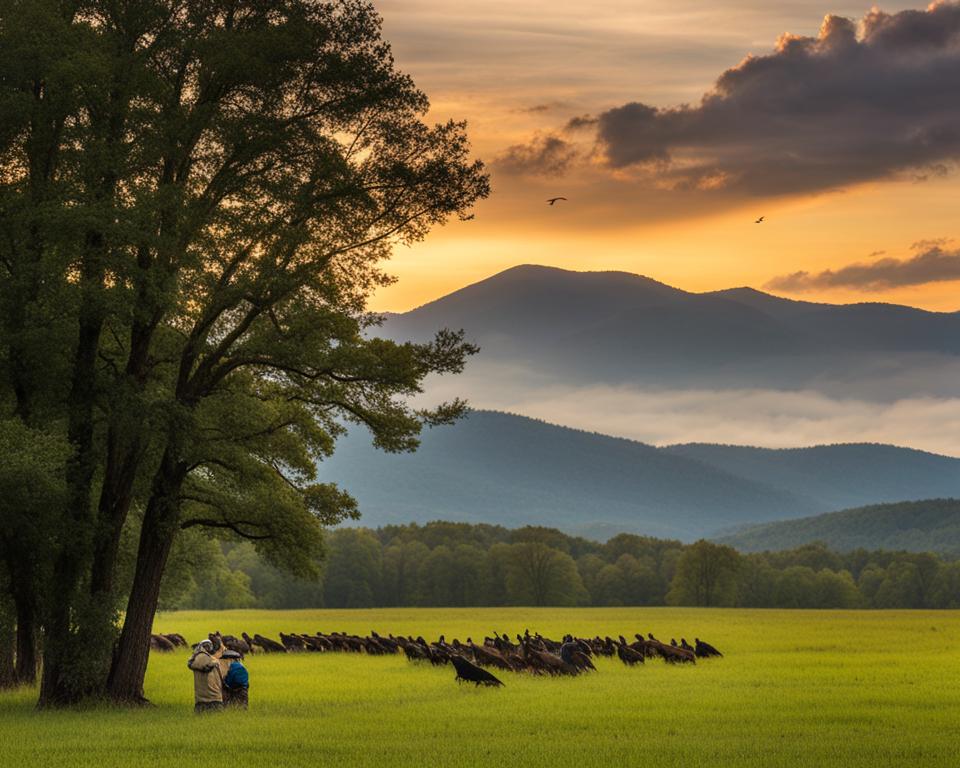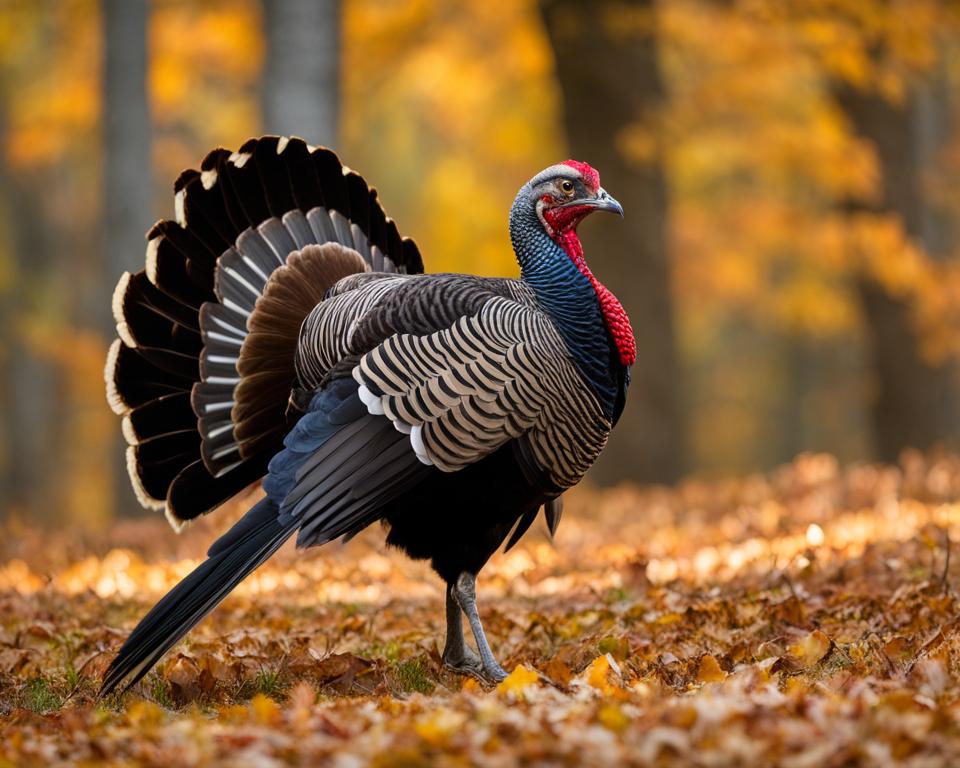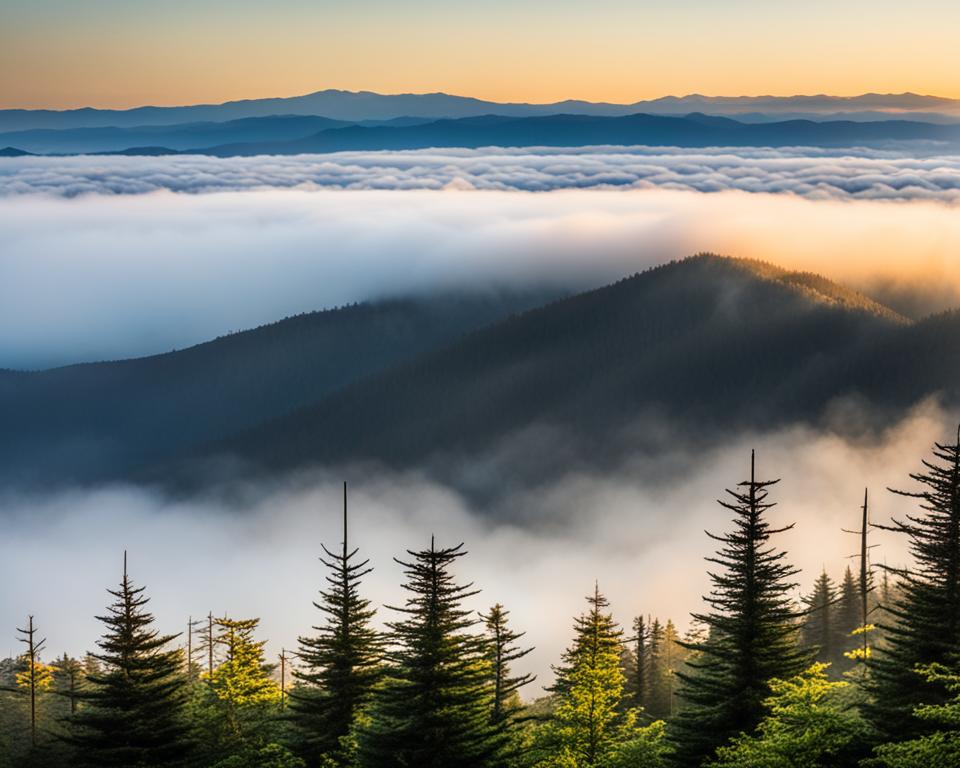
Birding in Cades Cove: Spot Feathered Friends!
If you’re a nature enthusiast looking for a wildlife adventure, birding in Cades Cove is an experience you won’t want to miss. Located in the Great Smoky Mountains National Park, Cades Cove offers breathtaking landscapes and diverse habitats that attract over 200 species of birds.
Whether you’re an avid birdwatcher or simply looking for a peaceful outdoor activity, birding in Cades Cove offers the perfect opportunity to spot feathered friends in their natural habitats. From wood ducks and yellow-crowned night-herons to eastern bluebirds, you’ll be amazed by the variety of bird species that call this area home.
Cades Cove features an 11-mile paved loop that takes you through mountains, forests, and rolling meadows. This scenic route offers prime birdwatching spots along the way, allowing you to immerse yourself in the beauty of nature while observing the local wildlife. Whether you prefer hiking or leisurely strolling, the loop caters to all levels of outdoor enthusiasts.
So grab your binoculars, lace up your hiking boots, and get ready to embark on an unforgettable birding experience in Cades Cove. Explore the prime birdwatching areas, discover the diverse range of bird species, and witness the beauty of these magnificent creatures up close and personal.
Prime Birdwatching Areas
The Great Smoky Mountains National Park offers a variety of prime birdwatching areas, including Cades Cove. This picturesque location features an 11-mile paved loop surrounded by mountains, forests, and rolling meadows. The lower elevation and milder climate of Cades Cove attract numerous bird species, making it an ideal spot for birdwatching. For more adventurous birdwatchers, hikes to Andrew’s Bald and Rainbow Falls offer the opportunity to explore deeper into the backcountry and discover different habitats and wildlife viewing opportunities.
When visiting Cades Cove, birdwatchers can enjoy the peacefulness of the loop while spotting birds in their natural habitats. The meadows and open fields within Cades Cove are perfect for catching glimpses of grassland species such as the Eastern Meadowlark and the Grasshopper Sparrow.
For a more challenging birdwatching experience, Andrew’s Bald and Rainbow Falls are excellent options. The hike to Andrew’s Bald provides opportunities to spot high-elevation species such as the Blackburnian Warbler and the Swainson’s Thrush. As you trek through the forests and streams towards Rainbow Falls, keep an eye out for birds like the American Redstart and the Black-and-white Warbler.
If you’re a birdwatching enthusiast seeking diverse habitats and lush environments, Cades Cove, Andrew’s Bald, and Rainbow Falls are not to be missed. With each area offering unique bird species and stunning landscapes, you’re sure to have an incredible birdwatching experience.
| Location | Key Bird Species |
|---|---|
| Cades Cove | Wood Ducks, Eastern Bluebirds, Yellow-crowned Night-Herons, and more |
| Andrew’s Bald | Blackburnian Warblers, Swainson’s Thrushes |
| Rainbow Falls | American Redstarts, Black-and-white Warblers, |
Birds of Cades Cove
Cades Cove is a haven for birdwatchers, offering a diverse array of bird species to admire. As you traverse the scenic loop, keep your eyes and ears open for incredible wildlife sightings. Here are some of the remarkable avian residents you may encounter in this mesmerizing landscape:
- Yellow-crowned night-herons
- Wood ducks
- Killdeers
- Least sandpipers
- Eastern bluebirds
- Red-winged blackbirds
- Scissor-tailed flycatchers
These mesmerizing birds showcase the beauty and diversity of the wildlife in Cades Cove. The vibrant plumage of the red-winged blackbirds and the distinctive calls of the eastern bluebirds add to the enchanting atmosphere of the area.
For a closer look at the splendid wild turkey, a true icon of the region, here’s an image:

| Bird Species | Description |
|---|---|
| Yellow-crowned night-herons | These striking birds possess a regal appearance, with plumage that varies from gray to black. They can often be found foraging along the banks of rivers and wetlands. |
| Wood ducks | Known for their vibrant colors, including iridescent greens, blues, and purples, wood ducks are a sight to behold. Look for them near wooded swamps and marshes. |
| Killdeers | These medium-sized shorebirds have a distinctive call that gives them their name. You may spot them in open grasslands or along the edges of bodies of water. |
| Least sandpipers | These small, energetic birds are usually found near shorelines and mudflats. They have long, thin bills, perfect for probing the sand in search of insects. |
| Eastern bluebirds | Eastern bluebirds are a symbol of happiness and good fortune. Known for their striking blue plumage, they inhabit open woodlands and forest edges. |
| Red-winged blackbirds | The males of this species are easily recognized by their glossy black feathers and vibrant red shoulder patches. Red-winged blackbirds inhabit wetlands and marshes. |
| Scissor-tailed flycatchers | These unique birds have long, elegant tail feathers that flutter as they catch insects in mid-air. Keep an eye out for them in open fields and farmlands. |
Hike to Grotto Falls
Embark on a memorable hiking adventure to Grotto Falls in the beautiful Cades Cove. This enchanting trail is perfect for both nature enthusiasts and birdwatchers, providing an opportunity to refine your birdwatching senses while immersing yourself in the stunning scenery. The hike is a comfortable 2.6-mile roundtrip, allowing you to indulge in the serenity of the Great Smoky Mountains National Park.
The trail to Grotto Falls is a breathtaking journey through a dense forest, offering a variety of habitats and a haven for winged species. As you make your way through the woodland, keep your eyes and ears open for the melodious tunes of the white-throated sparrow and the vibrant colors of the American goldfinch.
Equipped with your trusty binoculars, you’ll have the chance to spot these fine-feathered friends perched among the trees or flitting through the foliage. Take a moment to connect with nature and appreciate the intricate beauty of these avian creatures in their natural habitat.
“Birds are a gateway to experiencing the wonders of nature. The hike to Grotto Falls in Cades Cove provides the perfect opportunity to hone your birdwatching senses and forge a deeper connection with the captivating wildlife.”
Immerse yourself in the tranquility of nature and witness the wonders of birdlife as you explore the hike to Grotto Falls. Let the melodies of the white-throated sparrow and the charm of the American goldfinch create a lasting memory of your birdwatching adventure in Cades Cove.
Experience the magic of Grotto Falls and the captivating bird species it holds. Lace up your hiking boots, grab your binoculars, and embark on a journey that will stimulate your senses and leave you in awe of the diverse birdlife that calls Cades Cove home.
Bird Species Spotlight
| Bird Species | Habitat | Characteristics |
|---|---|---|
| White-throated Sparrow | Woodlands and forests | A distinctive song, a white throat patch, and yellow markings above the eyes |
| American Goldfinch | Fields, meadows, and woodland edges | Bright yellow plumage during breeding season, black wings with white markings, and a delightful song |
Clingmans Dome
For birdwatching at higher elevations, a visit to Clingmans Dome is a must. This spot offers unparalleled 360-degree views of the Great Smoky Mountains National Park and the opportunity to see seasonal birds and species in migration. Look out for birds such as the chickadee, Canada warbler, red-breasted nuthatch, and blue-headed vireo. Capture breathtaking photos of both the stunning views and these feathered inhabitants of Clingmans Dome.

| Bird Species | Characteristic |
|---|---|
| Chickadee | Small, active bird with a distinctive black cap and white cheeks. |
| Red-breasted Nuthatch | Small bird with brownish-gray plumage, a rusty-red breast, and a distinctive upward-spiraling call. |
| Canada Warbler | Small, brightly colored bird with a yellow throat, grayish head, and black necklace pattern. |
| Blue-headed Vireo | Medium-sized bird with a bluish-gray head, olive-green back, and white underparts. |
Birdwatching Seasons
The seasons in the Great Smoky Mountains National Park have a significant impact on bird migration patterns and behaviors. Each season offers unique opportunities for birdwatching enthusiasts to observe a variety of species in their natural habitats.
Spring
In spring, as the park bursts into life with vibrant colors and blossoming flowers, birdwatchers can expect an abundance of activity. This is an ideal time to visit for avid birders, as it coincides with the Spring Wildflower Pilgrimage, where you can witness the peak flowering season. Many migratory birds return during this season, adding to the diversity of bird species you can encounter.
Summer
Summertime in the Great Smoky Mountains offers mild weather and ample opportunities to spot birds that have flourished from the spring season. The park’s forests and meadows become home to a wide variety of species, each making the most of the favorable conditions. Whether you’re exploring the loops or embarking on a scenic hike, keep an eye out for these feathered inhabitants.
Fall
Autumn is a picturesque season in the Great Smoky Mountains, as the foliage transforms into a stunning display of red, orange, and gold. Fall attracts not only photographers and nature enthusiasts but also a variety of permanent-resident birds. The changing colors provide a breathtaking backdrop for birdwatchers, creating a picturesque setting to enjoy the presence of these feathered creatures.
Winter
In winter, the Great Smoky Mountains National Park transforms into a serene winter wonderland, offering a unique birdwatching experience. Cold-weather birds such as the white-breasted nuthatch, purple finch, and common goldeneye can be spotted against the snowy landscapes. The tranquility of the park during this season provides a peaceful backdrop for observing these resilient avian residents.
| Season | Key Features |
|---|---|
| Spring | Peak flowering season, returning migratory birds |
| Summer | Mild weather, diverse bird population |
| Fall | Breathtaking autumn colors, permanent-resident birds |
| Winter | Snow-covered landscapes, cold-weather bird species |
Get Into Birding!
If you’re new to birding, the Great Smoky Mountains are a great place to start. Birdwatching requires minimal gear, with binoculars being the most essential tool. Whether you’re a beginner or an experienced nature enthusiast, exploring the diverse habitats of Cades Cove and other prime birding areas can be both fun and educational.
Before you set off on your birding adventure, take some time to do some preparation. Familiarize yourself with the birds you hope to see and learn about their behaviors. This will help you identify different species and understand their habitats.
For a serene and relaxing birding experience, consider staying in one of the mountain cabin accommodations available in the Great Smoky Mountains. These cozy cabins offer the perfect setting to enjoy nature’s feathered friends right from your own deck. Imagine waking up each morning to the melodious songs of birds and sipping your coffee while observing their graceful movements.
So grab your binoculars, pack your curiosity, and embark on a birding adventure in the Great Smoky Mountains. Whether you choose to explore the enchanting forests of Cades Cove or relax in a mountain cabin, this is an opportunity to connect with nature and discover the beauty of birdwatching.
FAQ
Is Cade Cove a good place for birdwatching?
Yes, Cade Cove in the Great Smoky Mountains National Park is an excellent place for birdwatching, with over 200 bird species frequenting the area.
What are some prime birdwatching areas in Cade Cove?
Cade Cove itself is a great place for birdwatching, but other prime areas include Andrew’s Bald, Rainbow Falls, and Clingmans Dome.
What bird species can I expect to see in Cades Cove?
You can spot a variety of birds in Cades Cove, including wood ducks, yellow-crowned night-herons, eastern bluebirds, and red-winged blackbirds.
What birds can I see while hiking to Grotto Falls?
While hiking to Grotto Falls, you may have the chance to spot white-throated sparrows and American goldfinches among the wooded areas.
What bird species can I find at Clingmans Dome?
At Clingmans Dome, you may be able to see birds such as chickadees, red-breasted nuthatches, and blue-headed vireos.
What are the best seasons for birdwatching in the Great Smoky Mountains National Park?
Spring and fall are generally the best seasons for birdwatching, with the spring Wildflower Pilgrimage providing additional opportunities. Summertime and winter also offer their own unique birdwatching experiences.
What do I need to start birdwatching in the Great Smoky Mountains?
To start birdwatching, all you need are a pair of binoculars to help you spot the birds. It’s also helpful to familiarize yourself with the birds you hope to see and their behaviors.
Can I do birdwatching from a mountain cabin accommodation?
Yes, many mountain cabin accommodations offer the opportunity to do some birdwatching right from the comfort of your own deck, allowing you to enjoy nature’s feathered friends in a serene and relaxing environment.
Source Links
- https://www.cabinsforyou.com/gatlinburg_article/bird_watching_in_gatlinburg_pigeon_forge_area.htm
- https://experiencecadescove.com/blog/wildlife-in-cades-cove-summer/
- https://www.wate.com/news/local-news/6-explores-christmas-bird-count-in-cades-cove/